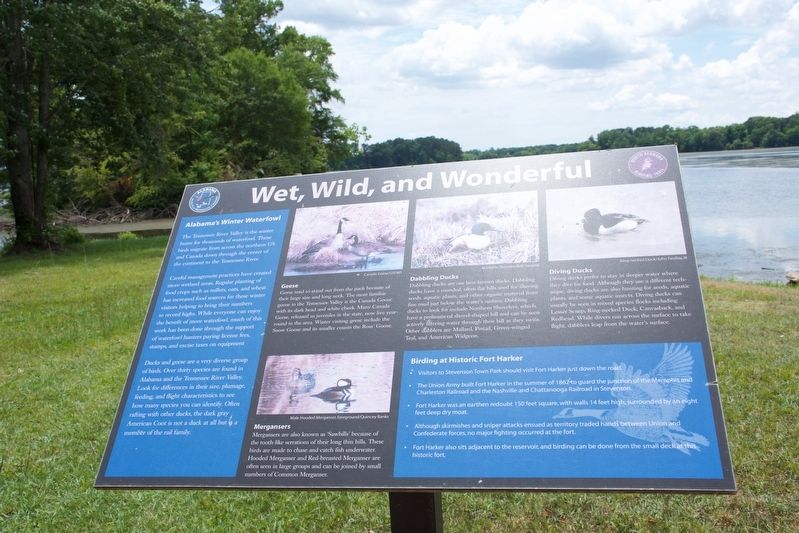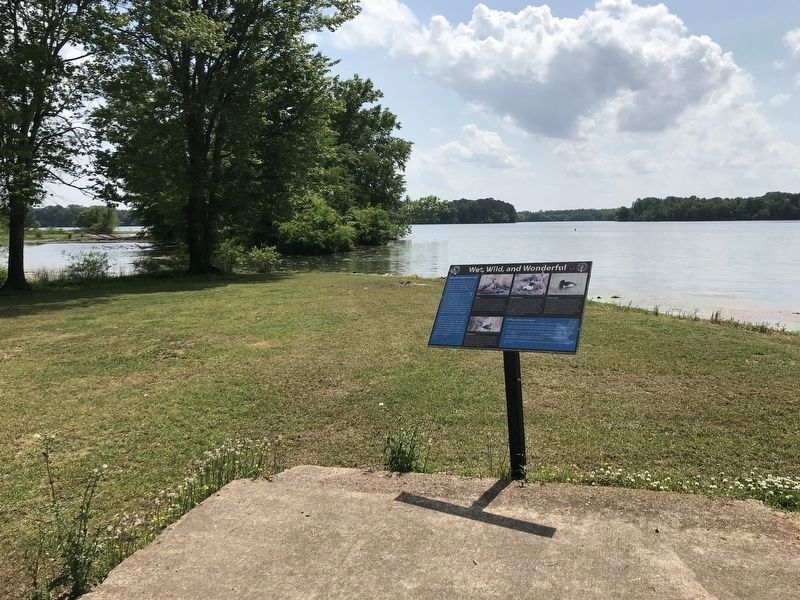Stevenson in Jackson County, Alabama — The American South (East South Central)
Wet, Wild, and Wonderful
Alabama’s Winter Waterfowl
The Tennessee River Valley is the winter home for thousands of waterfowl. These birds migrate from across the northern US and Canada down through the center of the continent to the Tennessee River.
Careful management practices have created more wetland areas. Regular planting of food crops such as millets, oats, and wheat has increased food sources for these winter visitors helping to bring their numbers to record highs. While everyone can enjoy the benefit of more waterfowl, much of this work has been done through the support of waterfowl hunters paying license fees, stamps, and excise taxes on equipment.
Ducks and geese are a very diverse group of birds. Over thirty species are found in Alabama and the Tennessee River Valley. Look for difference in their size, plumage, feeding, and flight characteristics to see how many species you can identify. Often rafting with other ducks, the dark gray American Coot is not a duck at all but is a member of the rail family.
Geese
Geese tend to stand out from the pack because of their large size and long neck. The most familiar goose in the Tennessee Valley is the Canada goose with its dark head and white cheek. Many Canada geese, released as juveniles in the state, now live year-round in the area.
Mergansers
Mergansers are also known as “Sawbills” because of the tooth-like serrations of they long thin bills. These birds are made to chase and catch fish underwater. Hooded Merganser and Red-breasted Mergansers are often seen in large groups and can be joined by small numbers of Common Mergansers.
Dabbling Ducks
Dabbling Ducks are our best-known ducks. Dabbling Ducks have a rounded, often flat bills used for filtering seeds, aquatic plants, and other organic materials from fine mid just below the water’s surface. Dabbling Ducks to look of r include Northern Shovelers, which have a pronounced shovel-shaped bill and can be seen actively filtering water through their bill as they swim. Other dabblers are Mallard, Pintail, Green-winged Teal, and American Widgeon.
Diving Ducks
Diving Ducks prefer to stay in deeper water where they dive for food, Although they use a different technique, diving ducks are also hunting for seeds, aquatic plants and some aquatic insects. Diving ducks can usually be seen in mixed species flocks including Lesser Scaup, Ring-necked Ducks, Canvasback, and Redhead. While divers run across the surface to take flight, dabblers leap from the water’s surface.
Birding at Historic Fort Harker
• Visitors to Stevenson Town Park should visit Fort Harker just down the road.
• The Union Army built Fort Harker in the summer of 1862 to guard the junction of Memphis and Charleston Railroad and the Nashville and Chattanooga Railroad in Stevenson.
• Fort Harker was an earthen redoubt 150 feet square, with walls 14 feet high, surrounded by an eight feet deep dry moat.
• Although skirmishes and sniper attacks ensured as territory traded hands between Union and Confederate forces, no major fighting occurred at the fort.
• Fort Harker also sits adjacent to the reservoir, and birding can be done from the small deck at this historic fort.
Topics. This historical marker is listed in these topic lists: Animals • Forts and Castles • Horticulture & Forestry • War, US Civil. A significant historical year for this entry is 1862.
Location. 34° 51.005′ N, 85° 50.001′ W. Marker is in Stevenson, Alabama, in Jackson County. Marker is on City Park Road south of Kentucky Avenue (Alabama Route 17), on the left when traveling south. Marker is located Bird Site #43 in Stevenson Town Park Northeast Loop. Touch for map. Marker is in this post office area: Stevenson AL 35772, United States of America. Touch for directions.
Other nearby markers. At least 8 other markers are within 9 miles of this marker, measured as the crow flies. Crow Town (approx. half a mile away); Bennett's Cove Cabin (approx. half a mile away); Fort Harker (approx. 0.9 miles away); Flight 800 Memorial (approx. 1.2 miles away); Stevenson Depot and Hotel (approx. 1.3 miles away); Union Army Headquarters (approx. 1.6 miles away); Averyville (approx. 1.7 miles away); Rocky Springs Church of Christ (approx. 8.6 miles away). Touch for a list and map of all markers in Stevenson.
Also see . . .
1. Goose. Wikipedia entry:
Geese are waterfowl belonging to the tribe Anserini of the family Anatidae. This tribe comprises the genera Anser (the grey geese), Branta (the black geese) and Chen (the white geese). Some other birds, mostly related to the shelducks, have "goose" as part of their names. More distantly related members of the family Anatidae are swans, most of which are larger than true geese, and ducks, which are smaller. (Submitted on July 29, 2017, by Sandra Hughes Tidwell of Killen, Alabama, USA.)
2. Mergus. Wikipedia entry:
Mergus is the genus of the typical mergansers, fish-eating ducks in the seaduck subfamily (Merginae). The genus name is a Latin word used by Pliny and other Roman authors to refer to an unspecified waterbird.[1][2] The hooded merganser, often termed Mergus cucullatus, is not of this genus but closely related. The other "aberrant" merganser, the smew (Mergellus albellus), is phylogenetically closer to goldeneyes (Bucephala). (Submitted on July 29, 2017, by Sandra Hughes Tidwell of Killen, Alabama, USA.)
3. Dabbling Duck. Ducks Unlimited website entry:
A dabbling duck is a type of shallow water duck that feeds primarily along the surface of the water or by tipping headfirst into the water to graze on aquatic plants, vegetation and insects. These ducks are infrequent divers and are usually found in small ponds, rivers and other shallow waterways, or else they may stay near the shallow, slower edges of larger waterways. (Submitted on July 29, 2017, by Sandra Hughes Tidwell of Killen, Alabama, USA.)
4. Diving Ducks. Beauty of Birds website entry:
The diving ducks here are placed in a distinct subfamily, Aythyinae. While morphologically close to the dabbling ducks (Livezey, 1986), there are nonetheless some pronounced differences such as in the structure of the trachea. mtDNA cytochrome b and NADH dehydrogenase subunit 2 sequence data (Johnson and Sorenson, 1999) indicate that the dabbling and diving ducks are fairly distant from each other, the outward similarities being due to convergent evolution. (Submitted on July 29, 2017, by Sandra Hughes Tidwell of Killen, Alabama, USA.)
5. Fort Harker. Wikipedia entry:
The design of the fort is typical of many built during the American Civil War. The fort was constructed as a square earthen redoubt, 45 meters (148 feet) on a side. The walls were constructed of rammed earth 4.3 meters (14 feet) high, surrounded by a 2.5 meters (8.2 feet) deep dry moat. The fort was armed with seven barbettes for heavy cannon, and a bomb-proof powder magazine. Access to the fort was by draw bridge across the moat. An eight-sided wooden blockhouse was situated at the center of the redoubt. (Submitted on July 29, 2017, by Sandra Hughes Tidwell of Killen, Alabama, USA.)
Credits. This page was last revised on November 28, 2023. It was originally submitted on July 29, 2017, by Sandra Hughes Tidwell of Killen, Alabama, USA. This page has been viewed 508 times since then and 34 times this year. Photos: 1. submitted on July 29, 2017, by Sandra Hughes Tidwell of Killen, Alabama, USA. 2. submitted on May 9, 2022, by Duane and Tracy Marsteller of Murfreesboro, Tennessee. • Bernard Fisher was the editor who published this page.

